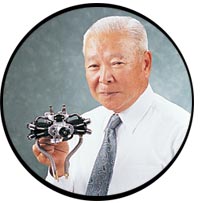 |
| Gen Saito, whose exacting standards mean every 4-stoke engine is conceived, tested and manufactured for his approval. |
There's no sound like the sweet sound of a Saito engine. Known as the "Friendly 4-Stroke", Saitos are known for their craftsmanship, outstanding power-to-weight ratio, ease of handling and, above all, reliability. We know you've heard all kinds of horror stories about the tiresome tinkering and exhausting adjusting that goes along with owning a fuss-budget 4-stroke. Like Bigfoot and the Loch Ness Monster, these tales are nothing but urban legends. You may remember how we shattered some of these myths in our previous quarterly. This time around, we break out our debunking cap once again, and elaborate further on the spirit of Saito.
Saito 4-stroke engines are conceived, tested and manufactured to the exacting standards of one man: Gen Saito. Gen is an avid modeler himself, and, having been a specialized producer of 4-strokes for several decades, knows exactly what it takes to produce flying enjoyment. He knows you want a high power-to-weight ratio; smooth, nuisance-free operation; and impeccable durability. Gen's competitors may dismiss these exacting features as "too troublesome" or "too expensive", but they're always standard on Saito engines. Gen runs his own show. That means everything is done his way. Discover the spirit of the Saito 4-stroke engine.
It purrrrrrrrrs like a pussycat.
Saito 4-strokes stand for beautiful, precision craftsmanship and that unmistakable 4-stroke sound. Whether you choose the standard all-silver model or a Golden Knight with black powder-coat crankcase and polished, golden valve covers, each Saito engine is a work of art. The second you fire one up, you'll be treated to that realistic sound that only a 4-stroke can offer. It's a beautiful sound, and you can rest assured you'll hear it with a Saito.
Another hallmark of the Saito 4-stroke is its outstanding power-to-weight ratio. Saito's innovative unitized cylinder plays a major role in weight reduction. The .72, for instance, is based on a modified .56 crankcase, and fits into the same space as most .60s. At just 16.6 oz., it's about 3 oz. lighter than other .72s, therefore giving you a much greater power-to-weight ratio. Since the 4-stroke has no through-bolts, the cylinder can be made smaller, allowing an undisturbed airflow through its cooling fins to reduce the fin area and, in turn, improve effectiveness. Maximum output and minimal complexity- the spirit of Saito.